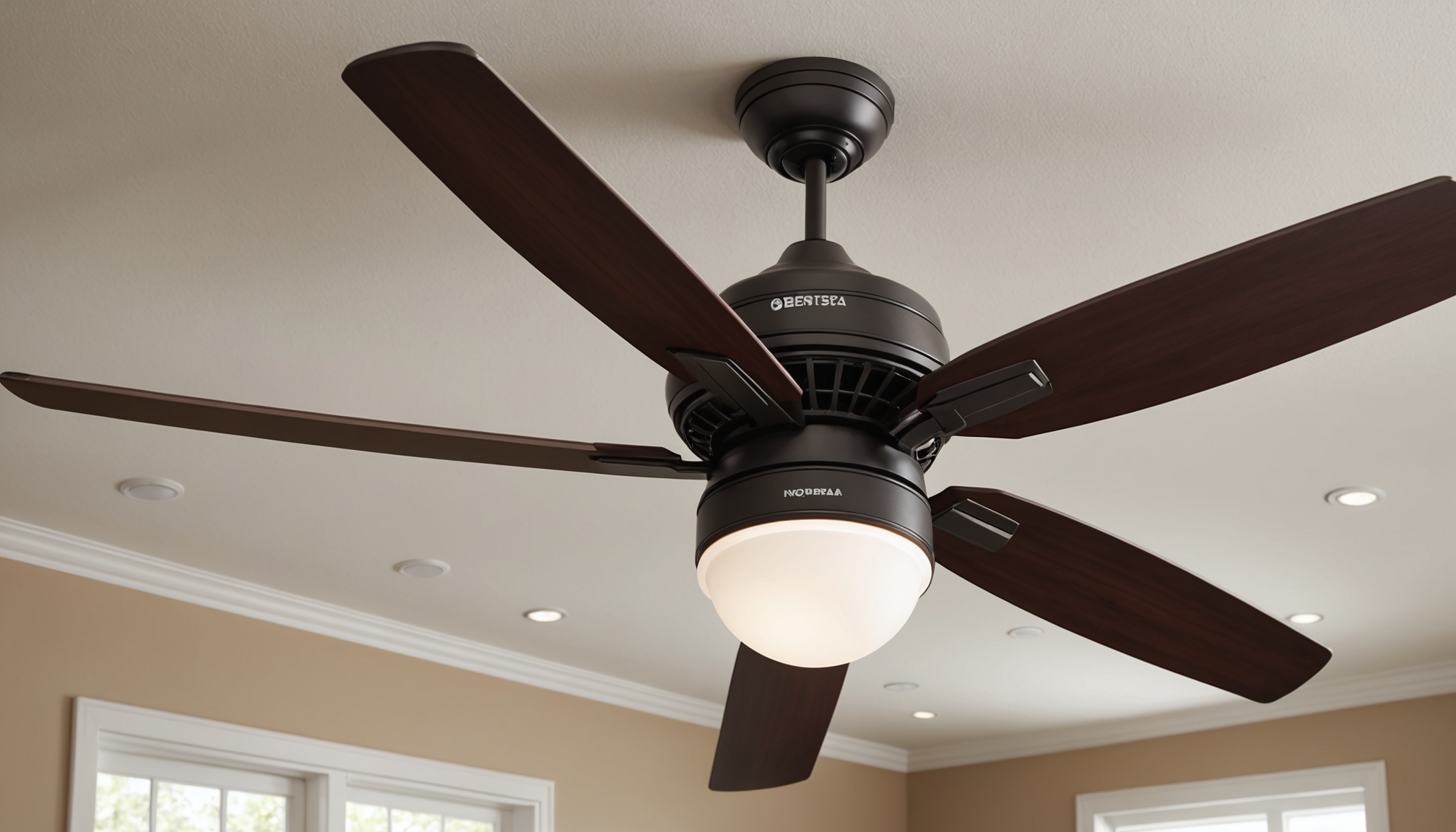In the pursuit of an energy-efficient home, understanding energy efficiency ratings is a crucial step. These ratings serve as a guide for consumers to evaluate how much energy a particular fan—or any appliance—consumes relative to its performance. Knowing what these ratings mean can significantly influence your purchasing decisions and long-term energy savings.
One of the most critical components in energy efficiency ratings is the Energy Guide label, which is mandated by the Federal Trade Commission in the United States. This label provides not only the estimated annual energy cost of running the appliance but also offers an efficiency comparison with similar models. For fans, this information can help you make an informed decision about which model delivers optimal performance for the least energy consumption.
Another essential element is the Energy Star certification. Products that earn the Energy Star label meet strict energy efficiency guidelines set by the Environmental Protection Agency (EPA). Fans with an Energy Star certification are generally 20-25% more efficient than standard models, thanks to advanced motor designs and improved blade engineering. The certification signifies not only reduced energy costs but also a commitment to environmental conservation.
Consumers might also encounter the CEER rating, which stands for Combined Energy Efficiency Ratio. Primarily applied to window air conditioning units, it’s starting to appear in evaluations of other household appliances, including fans. The CEER accounts for both cooling capacity and electrical energy input, providing a comprehensive efficiency metric over an operational season.
| Rating System | Description | Benefits |
| Energy Guide Label | Displays estimated energy costs and efficiency comparisons. | Helps consumers make cost-effective and energy-efficient choices. |
| Energy Star Certification | Identifies products meeting EPA guidelines for energy efficiency. | Assures lower energy costs and environmental benefits. |
| CEER Rating | Measures the efficiency of an appliance over a standard operational season, incorporating cooling capacity and energy use. | Provides an accurate efficiency measure across varied operation conditions. |
Understanding these ratings can illuminate the path toward a more sustainable home by aiding in the selection of fans that blend superb performance with optimal energy use. While the immediate focus might be on the operational costs, the long-term benefits extend to reduced environmental impact by lowering household energy consumption.
Selecting the right fan size for your space
When choosing an energy-efficient fan, selecting the right size is critical to maximizing both comfort and energy savings. A fan that is improperly sized for your space can either underperform or waste energy increasing your utility costs without the desired cooling effects. Here’s a step-by-step guide to help you determine the appropriate fan size for your room:
-
Measure the Room Dimensions:
- Start by measuring the length and width of the room where the fan will be installed. Note these dimensions in feet.
- Calculate the room’s square footage by multiplying the length by the width. This value will guide you in selecting the fan size.
-
Determine the Correct Fan Blade Span:
- For spaces up to 75 square feet, such as bathrooms or small home offices, a fan with a blade span of 29 to 36 inches is typically sufficient.
- Medium-sized rooms ranging from 76 to 144 square feet, like kitchens or bedrooms, benefit from fans with a blade span of 36 to 42 inches.
- Larger rooms, measuring 144 to 225 square feet, such as living rooms or master bedrooms, require a fan blade span of 44 to 50 inches.
- Very large areas exceeding 225 square feet, like open concept living spaces, may demand multiple fans or a single fan with a blade span of 52 inches or more.
-
Consider Ceiling Height:
- For ceilings standard 8 feet in height, a fan with a low mount or flush mount is usually ideal to maintain safety and efficacy.
- In rooms with ceilings over 8 feet, opt for a fan with an adjustable downrod to position the fan at an optimal height—usually between 8 to 9 feet from the floor.
- Ensure that the fan blades have at least 7 feet clearance from the floor to prevent accidents and ensure efficient airflow.
-
Account for Room Features:
- In spaces with unusual shapes or additional features, like partitions or alcoves, you may need to adjust the fan size or add additional fans for even coverage.
- For outdoor areas, consider weather-rated fans designed specifically with durability in mind.
-
Assess Your Comfort Needs:
- If you prefer a strong breeze or need more airflow, opt for a slightly larger fan within your recommended size range for increased rotation speed and greater air movement.
- Dual motor fans or models with multiple speed settings allow for adjustments aligning with varying comfort requirements throughout the year.
Choosing the right fan size not only contributes to energy savings but also enhances the overall comfort and appeal of your living space. By ensuring your fan is appropriately sized for your room and comfort levels, you can enjoy the benefits of efficient airflow while keeping energy costs in check.
Exploring different fan types and their benefits
In the quest to enhance energy efficiency within your home, understanding the types of fans available and their associated benefits can be instrumental. Various fan types are designed to meet different needs and contexts, each offering unique advantages in energy consumption and functionality.
Ceiling fans are a popular choice for general home use, known for their efficiency in circulating air throughout a room. Their primary benefit lies in their ability to create a cooling effect that allows you to feel cooler at higher thermostat settings, indirectly saving on air conditioning costs. Many contemporary ceiling fans are equipped with energy-efficient DC motors, which consume less electricity and operate more quietly than traditional AC motors. Additionally, reversing the fan direction can help distribute warm air in the winter, further optimizing energy use across seasons.
Tower fans offer a sleek, space-saving design ideal for smaller rooms or areas where floor space is limited. These fans typically feature a lightweight, portable build, making them easy to relocate as needed. Many models come with oscillation features that enable them to cover a broader area, contributing to uniform air distribution. The primary advantage of tower fans is their energy efficiency; they consume relatively little electricity while providing sufficient airflow to improve air circulation and comfort in smaller spaces.
Box fans are another economical and efficient choice, particularly suitable for those looking to maximize airflow with minimal operational costs. Box fans move a substantial volume of air and can be set near windows to facilitate cross-ventilation, effectively capturing cooler outside air and expelling warm indoor air. This method of passive cooling can significantly reduce your reliance on air conditioning, decreasing energy usage.
Pedestal fans offer the flexibility of height adjustment and broad oscillation, making them a versatile option for personalized cooling. Their strength lies in their ability to direct airflow precisely at occupants, providing targeted cooling that can reduce the need for more energy-intensive cooling systems. With multiple speed settings, pedestal fans allow users to fine-tune airflow according to their immediate comfort needs, further enhancing efficiency by preventing excessive use.
Whole-house fans provide comprehensive coverage by pulling cooler air through open windows and up into the attic, effectively ventilating the entire home. Ideal for homes in climates with cooler nights, whole-house fans can significantly cut down the need for air conditioning by refreshing interior air each evening, resulting in substantial energy savings. Installing these fans may involve a higher initial investment, but the long-term savings in reduced HVAC usage and their effectiveness in improving indoor air quality make them a valuable consideration.
Understanding the benefits and operational nuances of these different fan types enables you to select the model that aligns best with your home and lifestyle, optimizing both comfort and energy efficiency. Whether opting for the widespread circulation capabilities of a ceiling fan or the targeted cooling of a pedestal fan, each type offers pathways to reduce energy consumption while enhancing the comfort of your living environment.
Considering features for enhanced efficiency
When considering features for enhanced efficiency in your fan purchase, keep an eye out for several key components that can make a significant difference in both performance and energy savings. Today’s technologically advanced fans incorporate multiple enhancements that ensure they operate at peak efficiency while delivering the cooling effect you desire.
Firstly, opt for models that include variable speed settings. Variable speeds allow you to tailor the fan’s airflow to your current comfort needs, preventing unnecessary energy use when full power is not required. Fans with a wide range of speed settings give you the flexibility to adjust the air movement and find the perfect balance between comfort and energy efficiency.
In addition to speed settings, look for fans equipped with programmable timers. These timers enable you to set the fan to operate only during specific hours, reducing wasted energy when the room is unoccupied. A fan with a built-in timer can shut off automatically after a set period, offering convenience, energy savings, and greater control over your home’s climate management.
Remote control operation is another convenience feature that enhances a fan’s efficiency. With a remote, you can easily adjust the fan settings without having to leave your seat, ensuring you maintain optimal comfort levels with minimal effort. In many cases, these remotes come with additional features like breeze mode, which simulates natural wind patterns for improved airflow without unnecessary energy consumption.
Energy-efficient motors are a critical feature to consider in your fan selection process. Modern fans often include direct current (DC) motors, which are up to 70% more efficient compared to traditional alternating current (AC) motors. These motors use less electricity and can provide smooth, quiet operation, which makes your living space more comfortable while effectively lowering your energy bills.
Another innovation contributing to enhanced efficiency is the integration of smart technology. Smart fans can be controlled via smartphone apps or voice commands when integrated with your home’s smart system. This connectivity allows you to schedule, monitor, and manage fan operations remotely, ensuring the fan runs only when needed and at optimal settings for energy efficiency.
Lastly, remember to consider energy-efficient lighting if your fan includes a light fixture. Energy-efficient LED bulbs are a great choice as they consume significantly less electricity than traditional incandescent bulbs and have a longer lifespan. Combining a fan’s cooling capabilities with efficient lighting can lead to further energy savings.
By paying attention to these features, you can enjoy enhanced efficiency in your fan’s performance and your home’s overall energy use. Keep these considerations in mind as you explore fan options, and you’ll find a model that combines functionality and energy savings, aligning with your goals for a more efficient and comfortable living space.
Tips for optimizing your fan’s energy performance
Optimizing your fan’s energy performance is as much about strategic use as it is about selecting the right model. To maximize efficiency, position your fan thoughtfully within the room to enhance air circulation and utilize cross-ventilation by strategically placing it near windows or doorways. This setup facilitates the natural flow of air, reducing the reliance on air conditioning. Additionally, use your ceiling fan in conjunction with your HVAC system by allowing the fan to complement the cooling or heating effect, enabling you to adjust your thermostat accordingly.
Another essential tip is to regularly maintain your fan to ensure it operates at peak performance. Clean the blades and motor to prevent the accumulation of dust and debris that can impede function and increase energy use. Balanced blades also contribute to quieter operation and reduced wear on the motor. Consider investing in a fan blade balancing kit if you notice wobbling or noise during operation.
Taking advantage of advanced fan features is also crucial for energy optimization. Make use of built-in programmable timers and smart technology that allow for scheduled operation or integration with smart home systems, ensuring your fan is used only when necessary. Fans equipped with multiple speed settings provide the flexibility to adjust airflow to your precise needs, saving energy when maximum power isn’t required.
Finally, educate everyone in your household about these strategies to ensure consistent energy-saving practices. Small habit changes, like turning fans off when leaving a room, can cumulatively lead to substantial energy savings over time. By embracing these optimization strategies, you can enjoy a comfortable environment while keeping your energy consumption in check.
In conclusion, choosing an energy-efficient fan involves more than simply selecting a model with a good energy rating. Key considerations like appropriate sizing, understanding fan types, and evaluating enhanced features are all integral to maximizing energy savings and comfort. By implementing smart usage tips, proactively maintaining your fan, and harnessing advanced features, you can dramatically improve your home’s efficiency and reduce your energy footprint, making a significant positive impact on both the environment and your utility bills.


